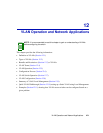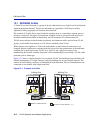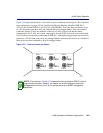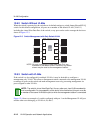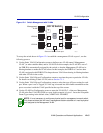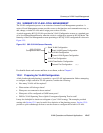
VLAN Switch Operation
12-8 VLAN Operation and Network Applications
12.6.1 Defining a VLAN
A VLAN must exist and have a unique identity before any ports or rules can be assigned to it. The
Administrator defines a VLAN by assigning it a unique identification number (the VLAN ID), a
filter database association, and an optional name. The VLAN ID is the number that will identify
data frames originating from, and intended for, the ports that will belong to this new VLAN.
12.6.2 Classifying Frames to a VLAN
Now that a VLAN has been created, rules are defined to classify all frames in a VLAN. This is
accomplished through management by associating a VLAN ID with each port on the switch.
Optionally, frames can be classified according to layer 2/3/4 information contained in the frame.
At the same time, the Administrator configures the trunk ports that need to consider themselves
members of every VLAN. The configuration of trunk ports is very important in multiswitch VLAN
configurations where a frame’s VLAN membership needs to be maintained across several
switches.
12.6.3 Customizing the VLAN Forwarding List
Each port on a VLAN-aware switch has a VLAN forwarding list that contains, as a minimum, the
Port VLAN Identifier (PVID) of the VLAN configured. Additionally, the Port VLAN Forwarding
List of each port can be configured to allow any number of VLANs to be added to its list.
12.7 VLAN SWITCH OPERATION
IEEE 802.1Q VLAN switches act on the classification of frames into VLANs. Sometimes, VLAN
classification is based on tags in the headers of data frames. These VLAN tags are added to data
frames by the switch as the frames are transmitted out certain ports, and are later used to make
forwarding decisions by the switch and other VLAN-aware switches.
In the absence of a VLAN tag header, the classification of a frame into a particular VLAN depends
upon the configuration of the switch port that received the frame.
The operation of an 802.1Q VLAN switch is best understood from a point of view of the switch
itself. To illustrate this concept, the examples that follow view the switch operations from inside
the switch.




